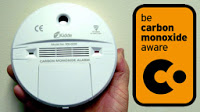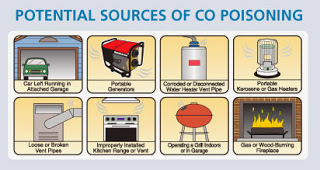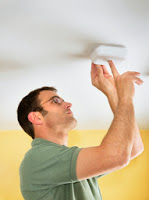Be Carbon Monoxide Aware
What is Carbon Monoxide?
While most of us have heard the horror stories and there certainly are some scary stories about carbon monoxide poisoning. Many people don’t realize carbon monoxide is a part of our every day life, created by and as a part of the healthy operation of our own bodies.
Carbon Monoxide is a colorless, odorless and tasteless gas that is produced by burning fuel. So that is right, your body burns fuel to operate, so do many other engines in your home, such as your furnace, gas ranges, gas fireplaces, wood burning stoves, water heaters and more. The car in your garage is one of the largest carbon monoxide factories in most homes.
Part of what makes carbon monoxide so dangerous is that it is completely non-irritating. As an asphyxiant, it starves the body of oxygen, frequently without it’s victim even knowing what is happening. In highly concentrated levels, it can be deadly. Carbon monoxide poisoning is the most common form of fatal air poisoning in many countries. Even at lower concentrations, long term carbon monoxide exposure can lead to diseases like hypertension, inflammation, seizures and more. Long term exposure can also have severe harmful effects on an unborn fetus.
What are the symptoms of carbon monoxide poisoning?
Different people may have different carbon monoxide tolerance levels, but on average, exposures at 100 PPM or greater can be dangerous to human health. The Journal of the Emergency Nurses Association and OSHA Guidelines on Carbon Monoxide list the following symptoms at these levels of exposure:
|
Concentration
|
Symptoms
|
|
35 PPM
|
Headache and dizziness occur with 6 to 8 hours of exposure
|
|
100 PPM
|
Slight headache occurs with 2 to 3 hours
|
|
200 PPM
|
Slight headache occurs with 2 to 3 hours; loss of judgement; tiredness, dizziness and nausea after 2 to 3 hours
|
|
400 PPM
|
Frontal headache occurs with 1 to 2 hours; life threatening exposure after 3 hours
|
|
800 PPM
|
Dizziness, nausea, and convulsions occur within 45 minutes of exposure; loss of consciousness with 2 hours; deadly with 2 to 3 hours exposure
|
|
1,600 PPM
|
Headache, tachycardia, dizziness and nausea occurs within 20 minutes of exposure; death occurs with 2 hours
|
|
3,200 PPM
|
Headache, dizziness and nausea occurs with 5 to 10 minutes of exposure; death occurs with 30 minutes of exposure
|
|
6,400 PPM
|
Headache, dizziness and nausea occurs with 1 to 2 minutes of exposure; convulsions, respiratory arrest and death occurs with less than 20 minutes of exposure
|
|
12,800 PPM
|
Unconsciousness occurs after 2-3 breaths; Death occurs with less than 3 minutes exposure
|
So What can we do to protect ourselves?
There are simple precautions every family and business should take to ensure safety. Any home or building that has fuel burning equipment should have carbon monoxide detectors installed.
According to the 2005 edition of the carbon monoxide guidelines, published by the National Fire Protection Association, CO detectors should “be centrally located outside of each separate sleeping area in the immediate vicinity of the bedrooms,” and each detector should “be located on the wall, ceiling or other location as specified in the installation instructions that accompany the unit.”
Many devices retail for $15- $60 and are widely available. Manufacturers are also marrying the CO detection technology with smoke detectors, allowing families to be protected from two dangerous threats with one easy to install and easy to operate detector. The standard for CO alarms to sound as of 2010 is 70 PPM. Todays’s more advanced detectors also monitor long term exposure sounding anytime they detect more than 30 days of levels at 30 PPM or higher. Carefully read the provided installation manual for each detector before installing.
The three most common causes of carbon monoxide poisoning in homes are:
- Auto exhaust from an attached garage
- Un-maintained or misused gas appliances
- Improperly vented appliances, negative pressures in the home
All of these can easily be taken care of with the help of your friendly Nebo Comfort Systems Comfort Advisor. Call us today and let us help you sleep safely and comfortably knowing your equipment is operating at peak efficiency and safety.


